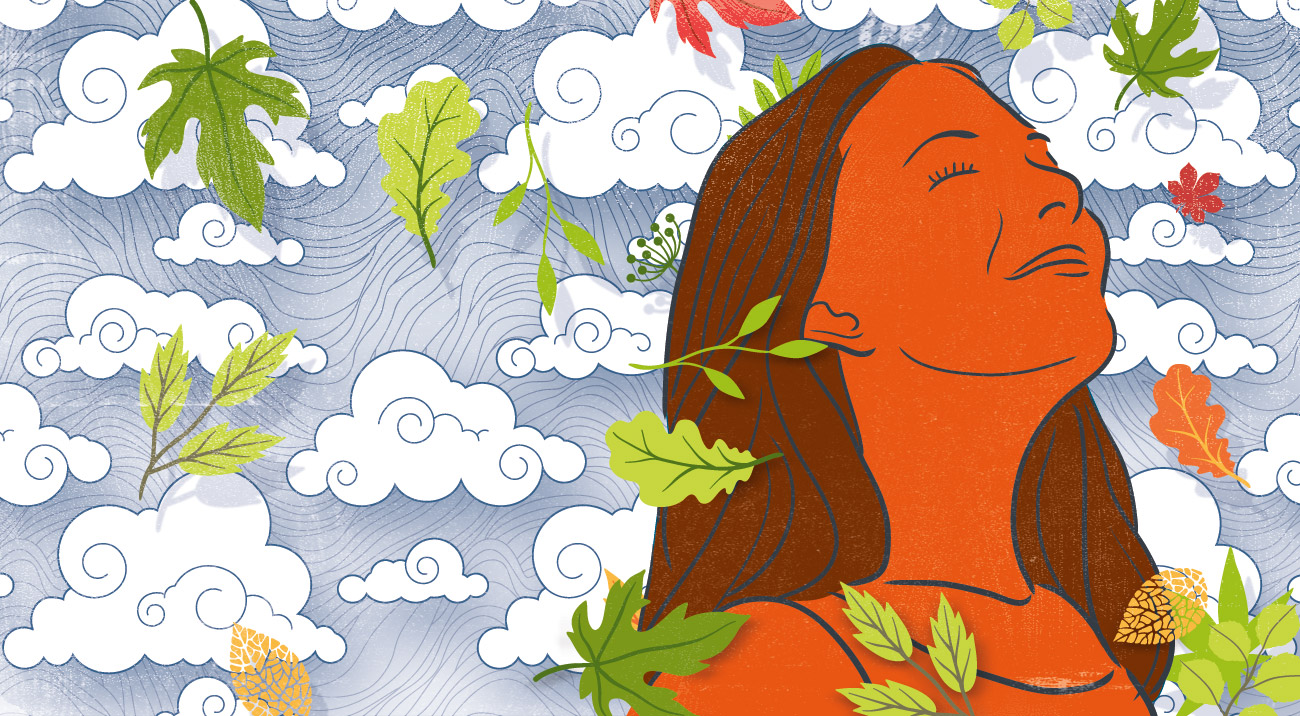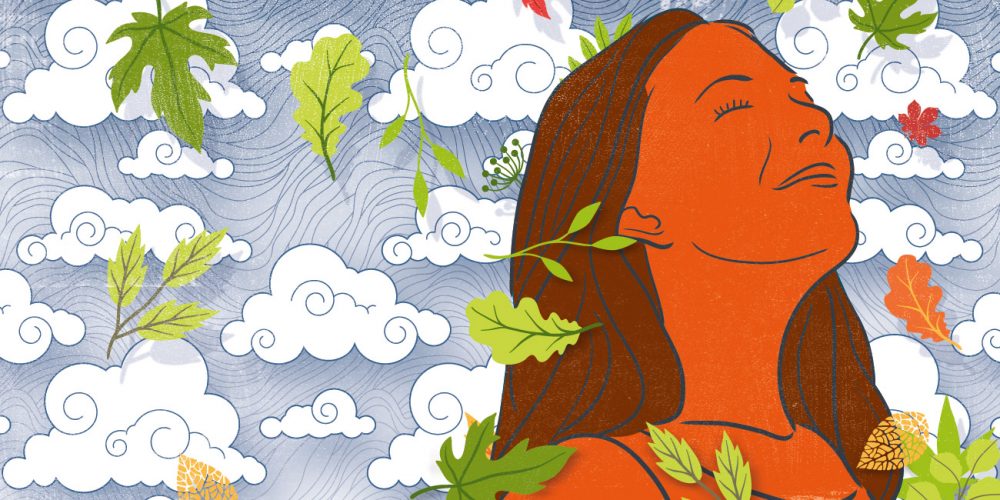
Psychologist Elizabeth Nisbet explains why greenery takes away the blues.
MUCH OF OUR discourse around environmental issues involves hazards like air and water pollution, deforestation, species extinction or the looming consequences of global climate change. Rarely do we ponder the importance of protecting the natural environment as a mental health resource.

Psychologist Elizabeth Nisbet explains why greenery takes away the blues.
MUCH OF OUR discourse around environmental issues involves hazards like air and water pollution, deforestation, species extinction or the looming consequences of global climate change. Rarely do we ponder the importance of protecting the natural environment as a mental health resource. Yet, increasingly, scientists from varied disciplines are investigating how interaction with the natural world can improve both physical and psychological health. For those feeling discouraged about the seemingly overwhelming environmental problems we face and the many barriers to changing destructive behaviour, the notion of nature as a source of health, healing and even happiness is exciting.
A growing body of evidence points to the importance of green space for mitigating the health hazards associated with urbanization, such as heart disease, respiratory illness, low birth weight, poor immune functioning and higher mortality. Several decades of research in Japan, Korea and Finland have demonstrated that natural and urban environments affect the human stress response differently. People immersed in nature show benefits on a variety of physiological indicators, such as heart rate variability, levels of cortisol (the “fight or flight” hormone), the presence of anti-cancer proteins and the natural killer-cell activity important for immune functioning.
Natural environments can enhance problem solving, concentration and social cohesion.
Contact with nature improves mental health as well. People suffering from clinical depression ruminate less and have more positive emotions after walking through an arboretum than after walking in an urban core. Beyond simply reducing stress and ill-being, natural environments can enhance problem solving, concentration and social cohesion. Not surprisingly, in greener communities neighbours interact more with each other and people feel safer and better adjusted.
Even brief contact with unspectacular urbanized nature can increase happiness more than we realize. Researchers who asked people to predict in advance what their mood would be like after a short walk in nature found they tended to underestimate how much it would boost positive emotions. Other research indicates that the greater the amount of nature time, the larger the happiness boost. An additional benefit of nature contact is a stronger sense of connection with the natural world. This has important implications for both happiness and environmentally friendly behaviour.
Because nature contact is lacking in our daily routines, researchers and organizations – including the Nature Connectedness Research Group at the University of Derby and the David Suzuki Foundation – are testing interventions that promote more nature time.This emerging research is informing nature-based programs like hospital gardens, therapeutic gardening, schoolyard greening, animal-assisted therapy, forest schools, “mood walks” and ecotherapy. As nature’s potential as a mental health resource is recognized, we can hope it will inspire further research, new clinical applications and, most importantly, a greater desire to protect our “happy” nature places.
 FROM NORTHERN NURSING stations to urban campus health clinics, my career as a family physician has taken me to some two-dozen communities across Canada. Though every practice population is unique, mental health issues cross socioeconomic boundaries, affecting one in five Canadians each year. Whether it is cross-country skiing on Inuvik’s world-class trails or running through Toronto’s ravine system, I seek out nature daily to unwind and recharge after hectic emergency shifts and long office days. Given the disparity in local healthcare resources, connecting with nature is a powerful way to combat stress, mood and attention disorders.
FROM NORTHERN NURSING stations to urban campus health clinics, my career as a family physician has taken me to some two-dozen communities across Canada. Though every practice population is unique, mental health issues cross socioeconomic boundaries, affecting one in five Canadians each year. Whether it is cross-country skiing on Inuvik’s world-class trails or running through Toronto’s ravine system, I seek out nature daily to unwind and recharge after hectic emergency shifts and long office days. Given the disparity in local healthcare resources, connecting with nature is a powerful way to combat stress, mood and attention disorders.
Nature exposure is certainly not a panacea for mental illness. Social inequalities, among other factors, also contribute to poorer health status. But for residents of rural and northern areas, who encounter higher rates of depression, access to green space and a close community could both be harnessed to improve well-being.
Just looking out a window at nature helps lower stress, but exercise in nature has still more positive effects. Since well-attended sports leagues exist in most towns, nature leagues would be a logical next step. The Mood Walks program jointly run by Hike Ontario and the Canadian Mental Health Association is a prime example of a partnership that emphasizes the health-promoting role of nature in neighbourhoods of all sizes.
Children have the most to gain from everyday green time.
Although it may be more challenging to find a meadow within a metropolis, mindfulness is key to getting more green time even there. City-dwellers can enjoy daily micro-experiences in nature by walking or biking to work and taking scheduled mental health breaks using nearby parks, gardens and trails. Detailed urban greenspace maps, like the groundbreaking one launched by Scotland in 2011, could help locate these calming green pockets. And because recreation in greener environments produces greater benefits, urbanites should make a routine of weekend encounters with wilderness in provincial and national parks.
Children have the most to gain from everyday green time – an effective remedy for the modern malady of excessive screen time. Sleep, school performance and social skills all suffer in avid television watchers. By contrast, stress goes down and self-esteem and cognitive function improve in youth with more nature contact. In fact, a 2009 study by A.F. Taylor and F.E. Kuo in the Journal of Attention Disorders showed that the attention-boosting effects of a 20-minute walk in the park for children with ADHD rivalled those of prescription stimulant medication. For developing brains, unstructured time in green space, cloud watching, tree climbing or fort building form the basis for a sound relationship with nature that can last a lifetime.
Removing barriers to green space access is essential. One-quarter of Japanese citizens regularly escape to government-funded shinrin-yoku or “forest-bathing” sites. Our governments could consider offering tax credits for passes to parklands or dues paid to nature societies. Physicians also have a role to play: Like recently introduced “exercise prescriptions,” nature prescriptions could be an effective motivational tool. To address parental concerns about stranger danger, organizations like the Children & Nature Network focus on linking up and educating families aiming to get outside together. Finally, advocating for greener cities and the preservation of wild spaces will help make nature more accessible for all.

Dr. Melissa Lem is a Toronto-based family physician who also works in rural and remote communities across Canada. She appears regularly on CBC Television’s Steven and Chris and holds a faculty appointment with the Department of Family and Community Medicine at the University of Toronto.

Dr. Elizabeth Nisbet is an Assistant Professor of Psychology at Trent University. Her research encompasses personality, social, health, and environmental psychology, exploring individual differences in ‘nature relatedness’ and the links between human-nature relationships, happiness, health, and sustainable behaviour. Her work is supported by the Social Sciences and Humanities Research Council of Canada (SSHRC) and appears in Environment and Behavior, Canadian Psychology, the Journal of Happiness Studies, and Psychological Science.













